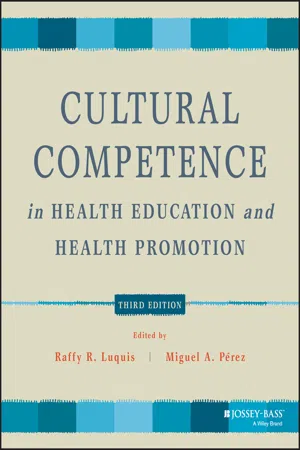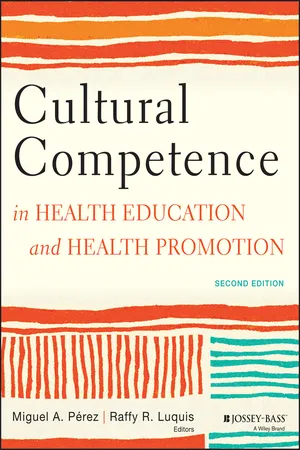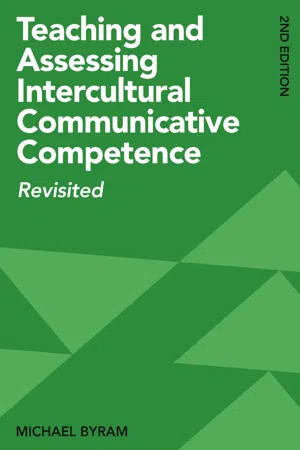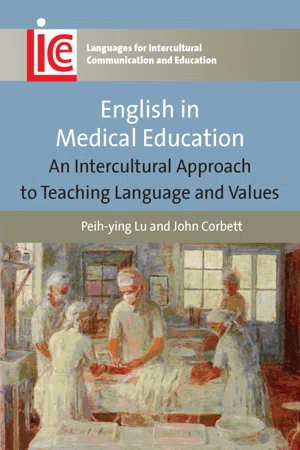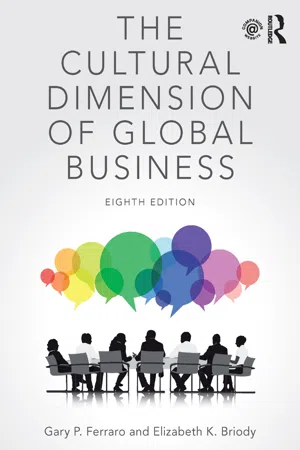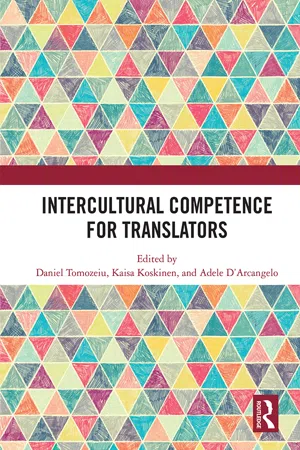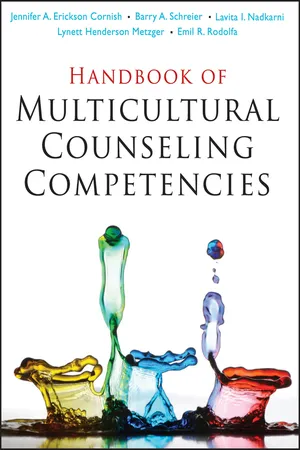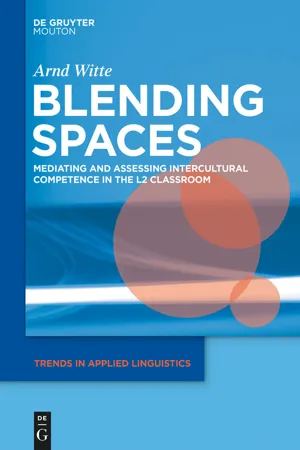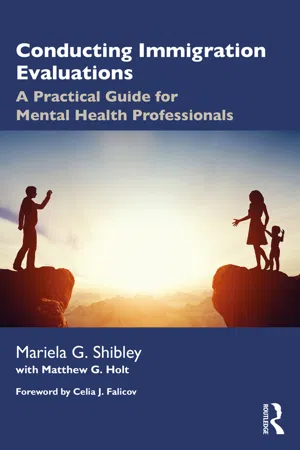Languages & Linguistics
Cultural Competence
Cultural competence refers to the ability to effectively interact and communicate with people from different cultural backgrounds. It involves understanding and respecting the values, beliefs, and behaviors of diverse groups, and adapting one's own communication and behavior to be inclusive and respectful. Developing cultural competence is essential for effective communication and collaboration in linguistically diverse environments.
Written by Perlego with AI-assistance
Related key terms
Related key terms
1 of 4
Related key terms
1 of 3
10 Key excerpts on "Cultural Competence"
- Raffy R. Luquis, Miguel A. Pérez(Authors)
- 2021(Publication Date)
- Jossey-Bass(Publisher)
n.d.‐b , para. 4). As such, Cultural Competence requires that organizations:- Have a defined set of values and principles, and demonstrate behaviors, attitudes, policies, and structures that enable them to work effectively cross‐culturally.
- Have the capacity to (a) value diversity, (b) conduct self‐assessment, (c) manage the dynamics of difference, (d) acquire and institutionalize cultural knowledge, and (e) adapt to diversity and the cultural contexts of the communities they serve.
- Incorporate the above in all aspects of policy making, administration, practice, and service delivery, and systematically involve consumers, key stakeholders, and communities. (NCCC, n.d.‐b , para. 3)
Acquiring Linguistic Competence
Health education specialists need to also understand the complexity of linguistic competence in order to become linguistically competent. The NCCC (n.d.‐b ) defines linguistic competence as “the capacity of an organization and its personnel to communicate effectively, and convey information in a manner that is easily understood by diverse audiences including persons of limited English proficiency, those who have low literacy skills or are not literate, and individuals with disabilities, and those who are deaf or hard of hearing” (para. 9). Further, the NCCC (n.d.‐b ) states that principles for language access include- Services and supports are delivered in the preferred language and/or mode of delivery of the population served.
- Written materials are translated, adapted, and/or provided in alternative formats based on the needs and preferences of the populations served.
- Interpretation and translation services comply with all relevant federal, state, and local mandates governing language access.
- Consumers are engaged in evaluation of language access and other communication services to ensure quality and satisfaction. (para. 10)
While becoming proficient in a foreign language may be helpful in bridging cultural and linguistic barriers, it is not necessary under current guidelines. It requires that individuals and organizations have the capacity to respond effectively to the health literacy needs of the populations served. The organization must have policies, structures, practices, procedures, and dedicated resources that support this capacity.- Miguel A. Pérez, Raffy R. Luquis(Authors)
- 2013(Publication Date)
- Jossey-Bass(Publisher)
- Incorporate the above in all aspects of policy making, administration, practice, service delivery and involve systematically consumers, key stakeholders and communities. (NCCC, n.d.b)
Therefore, given the cultural diversity of the United States, Cultural Competence becomes a complex process rather than an end point, and it is unrealistic for an organization to serve all cultural groups in a competent manner; rather, the organization must create an environment that supports an ongoing process of Cultural Competence.Acquiring Linguistic Competence
Health educators need to understand the intricacy of linguistic competence in order to become linguistically competent. The NCCC Conceptual Concepts/Models, Guiding Values and Principles (n.d.b) defines linguistic competence as “the capacity of an organization and its personnel to communicate effectively, and convey information in a manner that is easily understood by diverse audiences including persons of limited English proficiency, those who have low literacy skills or are not literate, and individuals with disabilities” (para. 9). As discussed in chapter 8, it is crucial for health educators to exemplify how health practitioners communicate and interact with racial and ethnic diverse populations in order to provide them with adequate health information to assist them in making decisions concerning their health and health care.Linguistic competence includes the use of (1) bilingual and bicultural or multilingual and multicultural staff; (2) cross-cultural communication approaches; (3) foreign language interpretation services, including distance technologies; (5) sign language interpretation services; (6) multilingual telecommunication systems; (7) print materials in easy-to-read, low-literacy, picture and symbol formats; (8) materials in alternative formats (e.g., audiotape, Braille, enlarged print); (9) materials developed and tested for specific cultural, ethnic, and linguistic groups; (10) translation services; and (11) ethnic media in languages other than English (e.g., television, radio, newspapers). It requires that individuals and organizations have the capacity to respond effectively to the health literacy needs of the populations served. The organization must have policies, structures, practices, procedures, and dedicated resources that support this capacity.- eBook - ePub
- Michael Byram(Author)
- 2020(Publication Date)
- Multilingual Matters(Publisher)
This account of competence focuses on linguistic capabilities but the term has been more widely used in education to refer to other capabilities taught and learnt in other disciplines (Fleming, 2009). In the model of ICC developed here, language competence is one aspect complemented by others and a more encompassing definition is required. The following is useful for my purposes here 3 : [competence is] the ability to mobilise and deploy relevant values, attitudes, skills, knowledge and/or understanding in order to respond appropriately and effectively to the demands, challenges and opportunities that are presented by a given type of context. (Council of Europe, 2018b: 32) The concept ‘communicative competence’ was developed in the Anglophone world by Hymes’ critique of Chomsky and in the Germanophone literature by Habermas. 4 Hymes argued that linguists wishing to understand first language acquisition need to pay attention to the way in which not only grammatical competence but also the ability to use language appropriately is acquired. He thus put emphasis on sociolinguistic competence and this concept was fundamental to the development of communicative language teaching. Then Hymes’ description of first language acquisition and communication among native speakers was transferred into the description of the aims and objectives of foreign language teaching and learning. I shall argue later that this transfer is misleading because it implicitly suggests that foreign language learners should model themselves on first language speakers, ignoring the significance of the social identities and Cultural Competence of the learner in any intercultural interaction - eBook - ePub
English in Medical Education
An Intercultural Approach to Teaching Language and Values
- Peih-ying Lu, John Corbett(Authors)
- 2012(Publication Date)
- Multilingual Matters(Publisher)
In the following sections, we review major models and draw comparisons between them. Task: Encountering otherness Take a few moments to recall your own experience of teaching or learning a foreign language. Did the language classes directly address the different cultural behaviour of the speakers of the other language(s)? If so, how was this done? • By explanation of the other culture, for example, by ‘cultural capsules’ of information? • By readings in textbooks or illustration through film and television? • By direct encounters with members of that culture, for example, teaching assistants, online correspondents, and so on? How would you now describe the attitudes that you, or your learners, formed towards speakers of the other language(s)? Were they positive or negative, stereotypically predictable or surprisingly complex? Defining Intercultural Communicative Competence The notion of ‘competence’ in language education has been subject to considerable refinement and re-evaluation for over half a century. The term was popularised in linguistic study by Noam Chomsky’s dichotomy between ‘performance’ (what actual language speakers did) and ‘competence’ (what ideal language speakers knew in order to be able to do what they did; see, e.g. Chomsky, 1965). Chomsky’s concern was principally with modelling an internalised grammar that would account for an ideal speaker’s ability to produce grammatically correct sentences. While educationalists today are less focused on idealised standards of ‘correctness’, it is still fair to say that most language teachers aim towards increasing their learners’ ability to use the target language in accordance with rules of accuracy, whether these be internationally exported or locally produced - eBook - ePub
- Gary P. Ferraro, Elizabeth K. Briody(Authors)
- 2017(Publication Date)
- Routledge(Publisher)
Cultural Competence (knowledge of cultural norms, rules, and beliefs) are valuable skills in the global workplace. In fact, because of the close relationship between language and culture, it is virtually impossible not to learn about one while studying the other.Communicate more, misunderstand less, partner betterConsider this example. Isuzu Motors Ltd. requested a meeting with its strategic alliance partner GM in the U.S. to resolve criteria issues related to brakes. About 20 people were present. Three were Japanese speakers, four were bilingual English-Japanese, and the remainder spoke only English. One issue concerned the “operating forces relative to gradient that complied with FMVSS.” The U.S. Federal Motor Vehicle Safety Standards required 112.5 lbs. of force for its parking brake when the light-duty truck was parked on a 20 percent grade (slope). Isuzu had a proposal to meet this requirement. A discussion ensued between the GM park brake expert (Donald), the interpreter (Dan), two integration engineers (Len and James), and a general assembly engineer (Mary). (See page 97 .)Language plays a vital role in helping people understand each other. Without some ability to communicate, business ventures cannot be successful. In this strategic alliance, language differences were managed in two important ways. First, both firms selected at least some employees with language skills in both English and Japanese. Isuzu employees also took English-language classes. Second, “language interpreting” by designated employees was a routine part of the alliance’s work activities; these employees have been referred to as “bridge individuals” or “linking pins” because of their bilingual, and sometimes multilingual skills (Harzing et al - eBook - ePub
- Daniel Tomozeiu, Kaisa Koskinen, Adele D'Arcangelo(Authors)
- 2018(Publication Date)
- Routledge(Publisher)
intercultural competence rather than Cultural Competence. It is also worth noting that some authors refer to interCultural Competence (Katan 2001; PICT 2012) rather than Cultural Competence in order to state more explicitly the idea that there is a constant movement between two cultures. However, this constant bicultural movement is also present in other authors that use the term Cultural Competence as we do. We believe that this is more a matter of designation rather than of content (see, for example, Witte 1987).Witte defines translation-specific Cultural Competence as:the ability of consciously learning something which is not yet known in both the own and the other (foreign) culture, and the ability to relate both cultures to each other, compare them with the aim of a purposeful and situation adequate reception and production of behaviour for the needs of at least two interacting partners from two different cultures in order to achieve communication between these interacting partners. (2000, 172; translated in Schäffner 2004, 488–489)Witte divides the competence in question into two sub-competences:– General Cultural Competence: awareness of the problems caused by differences in behaviour in inter- and intracultural communication and the conditions that influence such behaviour.– Specific Cultural Competence: the main competence, which is acquired in relation to a particular pair of cultures and languages but can be applied to other cultures.According to Witte, Cultural Competence is based on a process of consciously learning about a pair of cultures and applying the acquired knowledge to help two members of different cultures communicate with each other.Katan, meanwhile, observes that intercultural competence addresses:the motivation, the values and the beliefs involved when participating in another community. Hence it is the intercultural skills which will constrain or promote the immanent communicative abilities. (2001, 296) - Jennifer A. Erickson Cornish, Barry A. Schreier, Lavita I. Nadkarni, Lynett Henderson Metzger, Emil R. Rodolfa, Jennifer A. Erickson Cornish, Barry A. Schreier, Lavita I. Nadkarni, Lynett Henderson Metzger, Emil R. Rodolfa(Authors)
- 2010(Publication Date)
- Wiley(Publisher)
Knowledge regarding these cultural and linguistic factors is relevant in assessment, diagnosis, and case conceptualization in that it provides the assessor with information regarding normative second language development processes and reactions, as well as the most widely accepted and best-researched methods in which to effectively teach ELLs. This information allows the assessor to view SLA-related referral concerns through a cultural and linguistic lens. In addition, it is important for a professional assessing an ELL to have knowledge about these different processes, as they impact decisions regarding language of assessment, interpretation, conceptualization, and recommendations derived from the assessment. Skills and values related to these topics are discussed in the relevant sections that follow.According to Ortiz (2002), “linguistic competence,” requires a “knowledge base related to first and second language development and instructional methodology and pedagogy” (p. 1324) in addition to speaking the ELL's first language fluently. Although the majority of mental health practitioners do not meet the second criteria, most can work toward meeting the first. Once knowledge in these areas has been obtained, the next step is to utilize this knowledge to guide decision making on issues such as the language of assessment and/or intervention and to guide interpretation of assessments that will lead to appropriate conceptualizations, diagnoses, and recommendations. The mental health practitioner must use caution to ensure that information obtained through the clinical interview is not viewed as pathology when it may be a reflection of linguistic differences.Ethical and Legal ImplicationsIn 2001, recognizing that culture and language affect the service delivery of health and mental health care, the U.S. Department of Health and Human Services, Office of Minority Health, created a set of national standards for the provision of culturally and linguistically appropriate services (CLAS). Four of the 14 standards are related to Language Access Services. Standards 4 to 7 (as described in more detail later) are based on Title IV of the Civil Rights Act of 1964.- eBook - ePub
- Arnd Witte(Author)
- 2014(Publication Date)
- De Gruyter Mouton(Publisher)
Section 10.2 .The general goal of L2 learning is for the subject to develop, holistically, fundamental linguistic, pragmatic, social, cultural, and discursive knowledge and skills, including an explicit understanding of relevant aspects of tacit cultural knowledge and presuppositions of the cultures involved. This is necessary in order to successfully interact in the other language in a spontaneous and appropriate manner, and to develop viable states of intersubjectivity. However, communicative competence is only part of the broader interCultural Competence which implies progressive familiarization with the Other and a reciprocal alienation of aspects of the internalized L1 categories, values, and norms of constructing self, Other, and world (cf. Chapter 2). This reciprocal element of L2 encounter was acknowledged by Goethe as long as almost 200 years ago when he wrote: “Wer fremde Sprachen nicht kennt, weiß nichts von seiner eigenen” [Those who know nothing of foreign languages know nothing of their own] (Goethe 1973: 508; my translation, A.W.). In the processes of defamiliarizing internalized categories and familiarizing with the other linguistic and sociocultural patterns, values, and beliefs, the L2 learner develops successively blended intercultural third places in a relational manner, located on a continuum between the dominant Discourses, norms, values, attitudes, meanings, and patterns of the languages and cultures involved. These dynamic third places function as the momentary, yet transient bases for his or her processes of construction on cognitive, emotional, and behavioral planes. They are characterized by a degree of dynamic in-betweenness, or inter, which belongs - eBook - ePub
Conducting Immigration Evaluations
A Practical Guide for Mental Health Professionals
- Mariela G. Shibley, Matthew G. Holt(Authors)
- 2022(Publication Date)
- Routledge(Publisher)
How we express cultural humility is also very important. We all sense when a person is asking a question out of genuine curiosity versus a camouflaged condescending attitude with a preconceived notion of the answer. This is very common when interviewing individuals from different cultural backgrounds—especially when the interview is conducted in the client’s second (and less proficient) language. We will discuss language in the next section, but what is important to highlight here is the importance of taking an interpersonal stance of humility when working with foreign nationals (FNs).Some people are known to talk to those who lack command of the English language as if they were intellectually unsophisticated. It is important to acknowledge that just because a person does not have an advanced vocabulary through which to express themselves does not mean they lack experience, knowledge, or maturity. This is also often the case when working with elders, unfortunately. I remember accompanying my grandmother to the emergency room and her turning to me and saying, “Why does the doctor talk to me like I’m an idiot?”Both Cultural Competence and cultural humility are indispensable for understanding those from differing cultural backgrounds. The combination of these two abilities results in cultural attunement (Falicov, 2014 ), and this is true both in forensic and therapeutic settings. Being attuned to your client will allow for a more accurate and nuanced understanding of that person’s experience.Acculturation
Acculturation is the degree to which an individual has adapted to the dominant culture where they now reside. The Canadian psychologist John Berry (1997) - eBook - ePub
On the Subject of English
The Linguistics of Language Use and Learning
- Henry Widdowson(Author)
- 2019(Publication Date)
- De Gruyter Mouton(Publisher)
The argument for this reconceptualization of language pedagogy is that because it is consistent with the pragmatics of actual lingual communication it is in accord with, and not in conflict with, the natural disposition of learners. Furthermore, it provides an investment for further learning. For a lingual capability enables learners to make use of any subsequent linguistic experience to extend the repertoire of their resources to meet the demands of new contexts and purposes. If these contexts and purposes call for a closer approximation to “maximal” competence, then the learners as users will approximate because it is communicatively appropriate to do so and not otherwise. Bilingual competence of whatever degree – partial, minimal or maximal – is only achieved through the exercise of lingual capability.My argument in this chapter is that the way language is taught should be consistent with the way language is used and not in conformity to how a particular language is used . And this means focusing attention on the communicative process itself and dissociating it from how it is realized in particular languages. Thus instead of persisting in attempts to teach learners to be bilingually competent in one or more language we need to develop in them a capability for use, an investment in what is currently referred to as “transferable skills” which, consequently, enables them to extend their lingual repertoire, subsequently, as and when occasion requires them to do so in the future. To put it another way, instead of trying to teach people how to be bilingually competent in a particular language, better to get them to learn how to extend their more general lingual capability. In a way, this is simply a foreign language pedagogy version of the old Chinese adage:Give a man a fish and you feed him for a day. Teach a man to fish and you feed him for a lifetime.19 Competence and capability: rethinking the subject English
Note: Published in the 2014. Journal of Asia TEFL 11 (4). Originally a plenary presentation at the 12 TEFL Conference, Manila, October 2013.What do teachers of English do? They teach English, of course. Other teachers teach history, or geography or physics and they teach English. That is their subject. How they teach it may differ in all kinds of ways, and there is plenty of diverse opinion about the best way, but what they teach seems to be straightforward enough, and not a matter of dispute. In this chapter, I want to suggest that, on the contrary, there is a problem about what English is taught, and that this problem is at the very heart of TEFL – in Asia and everywhere else.
Index pages curate the most relevant extracts from our library of academic textbooks. They’ve been created using an in-house natural language model (NLM), each adding context and meaning to key research topics.
Explore more topic indexes
Explore more topic indexes
1 of 6
Explore more topic indexes
1 of 4
